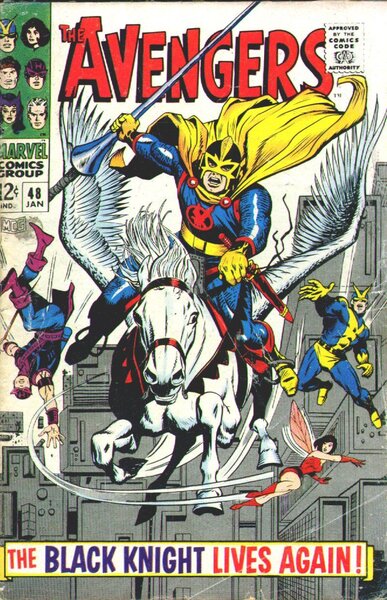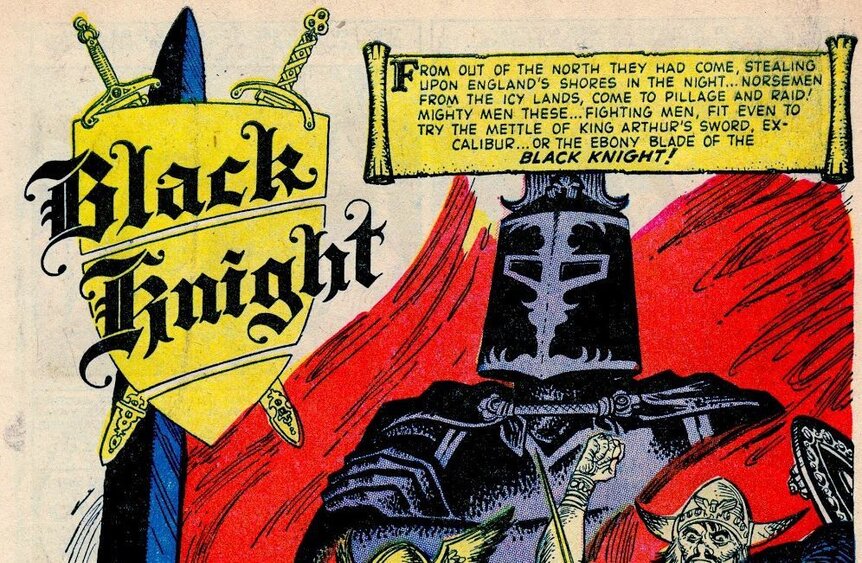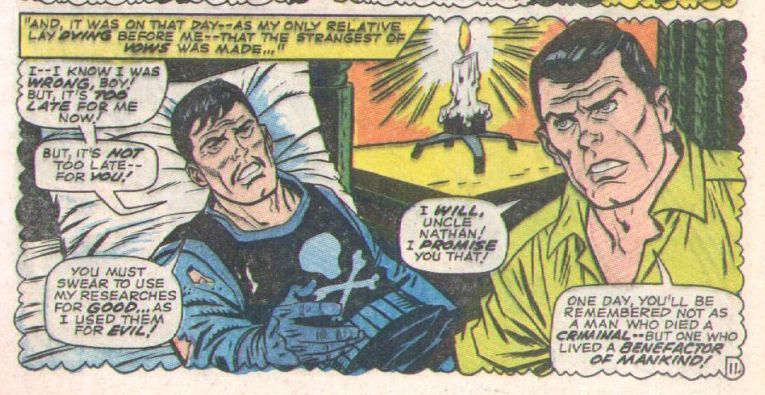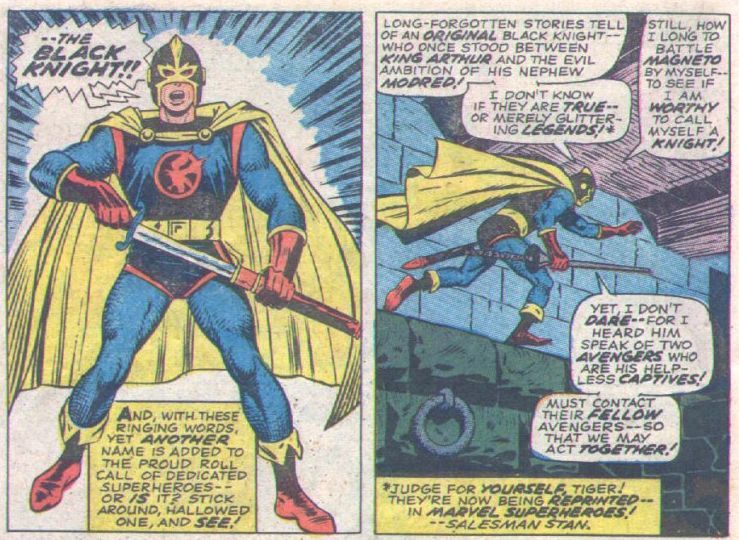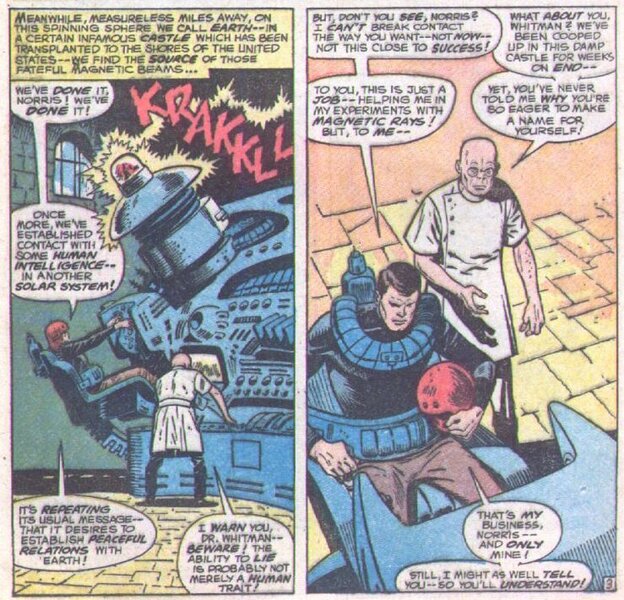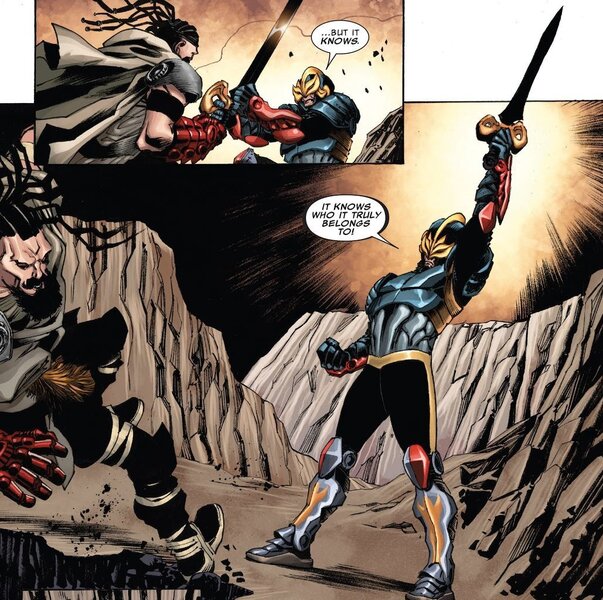Create a free profile to get unlimited access to exclusive videos, sweepstakes, and more!
The creator of Wolverine, Black Knight, and Ultron explains their origins and rates their movies
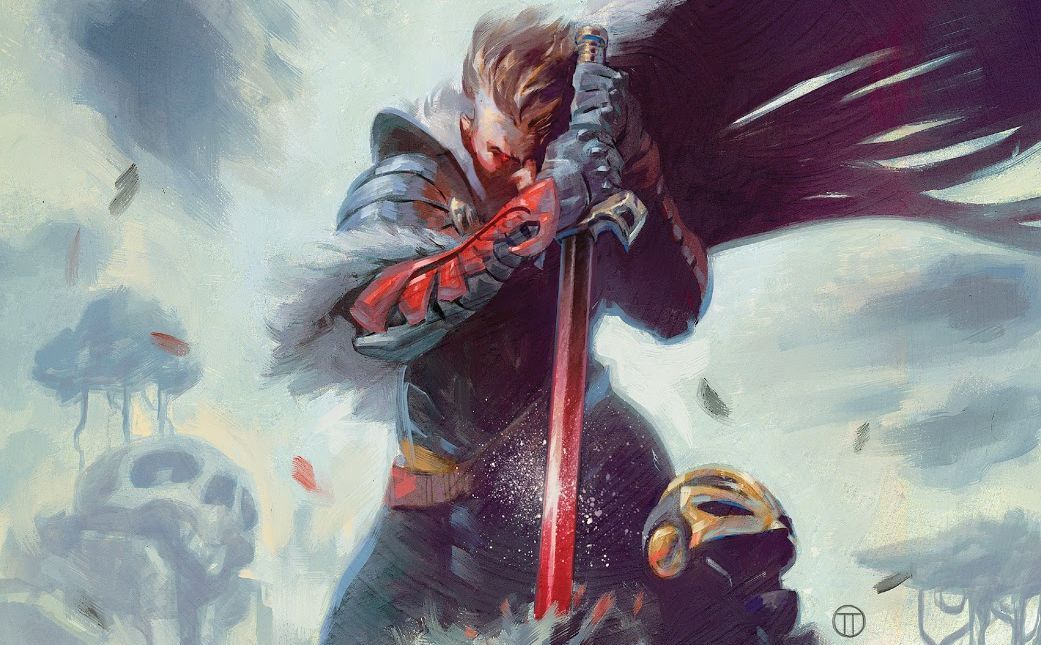
While fans continue to speculate how the Marvel Cinematic Universe will continue when Avengers: Endgame arrives in April, talk about the Quantum Realm and the role it may play in future films has ratcheted up over the past months. Recently, MCU Cosmic's Jeremy Conrad teased that the occasional Avenger Black Knight could make an appearance in the MCU very soon via the alternate dimension featured in Doctor Strange and both Ant-Man films.
While still a rumor, the idea could work as Dane Whitman — the third and arguably the most popular version of the Black Knight — holds a Master's degree in physics and has traveled to alternate universes, through time and into other dimensions. To get the lowdown on Black Knight, we went to the source, co-creator Roy Thomas, who explained how Black Knight joined the Avengers, who he'd like to see in the role if Dane Whitman joins the MCU and how he revamped an old hero.
A literary stock character, Black Knight first entered the realm of comic books in 1955, when Marvel was still known as Atlas Comics, courtesy of Stan Lee and Joe Maneely. Lee, inspired by the Arthurian legends of old, flipped the idea of the villainous Black Knight to create Sir Percy of Scandia, a 6th-century knight in King Arthur's court. Gifted with the Ebony Blade — an enchanted sword created by Merlin that can cut through anything — Sir Percy battles the evil Mordred. Sir Percy's adventures only lasted five issues before he was killed while slaying Mordred. But, Lee wasn't finished with the character.
Lee revived the Black Knight almost a decade late when he created the biologist and professor Nathan Garrett, who became a villainous version of the old hero. As heroes like Iron Man, Captain America, and Giant Man were gaining popularity in the pages of Tales to Astonish, Lee pitted the new Black Knight — who finds his ancestor Percy's tomb and the Ebony Blade — against the burgeoning superhero team in Tales to Astonish #52 in 1963 and in The Avengers #6 the next year. Unworthy of wielding the Ebony Blade and shunned by the ghost of Sir Percy, Garrett creates an arsenal of medieval inspired weapons including a genetically-engineered winged horse.
Although he logged only 15 appearances, Garrett battled with likes of the Fantastic Four and joined the Masters of Evil alongside Baron Zemo before being mortally wounded in a battle with Iron Man in Tales of Suspense #73 in 1966.
One year later, Lee's protege Roy Thomas revived the Black Knight in the pages of The Avengers #48. Thomas, who created the Vision, Carol Danvers, Iron Fist, and dozens of other characters during his time at Marvel, revisited the story that Lee penned in Tales of Suspense. Before dying, Garrett revealed his secret identity to his nephew Dane Whitman, who in turn adopted the identity of the Black Knight. Thomas told SYFY WIRE (via Thomas' business manager John Cimino) that he's truly amazed that Marvel might be using another one of his characters.
Can you tell me what you remember, as a fan, from those original Arthurian-age Black Knight comics from the 1950s? Did those comics stick out for you as a fan?
I didn't just remember the 1950s Black Knight comics; I owned copies of them, probably all of them, at that time. I had loved them from the start, both the Stan Lee writing in #1 (and the similar feel in later issues, whether he wrote them or not) and the artwork by Joe Maneely, who was really a magnificent artist. The language and the art made it a superior comic. Then, of course, Stan and Jack had made up a villain Black Knight, unrelated to him, as one of the Masters of Evil in The Avengers.
If you could cast him yourself, who in Hollywood would you like to see in the role? What kind of actor would work best?
Not a muscle-man, but a guy who could move in the relatively light armor the Black Knight wears. Most leading-man types would work, I think, since they don't have to be Schwarzenegger. Downey could've done it. You wouldn't need a Chris Hemsworth. He needs to be able to seem both noble, like an ancient knight, and a 21st Century man at the same time.
Can you tell me about creating the character with John Verpoorten and George Tuska? What kind of changes did you want for the revamped character?
I wanted to do a hero that combined aspects of the two Black Knights that had preceded him — a hero who would eventually prove to have true Arthurian antecedents (as I gave him in that Marvel Premiere solo story very shortly afterward) and yet be a modern man, like the evil one. By coincidence, I had dialogued the Iron Man story in which that Black Knight had "died" — so I kept him dead! I liked the idea of the winged horse, which Stan and Jack had added and I had always enjoyed the concept of DCs 1940s/early 50s hero, the Shining Knight, so those were my influences.
John Verpoorten was assistant production manager and a friend, so he volunteered to stay after work with me one night and draw the character, updating the 1950s costume (showing more of the face, etc.) We went over every individual bit of the costume. I think we still kept it a bit too busy, not as focused as Iron Man or even Thor, but he was never intended to be more than a secondary hero... an Avenger, but not a solo star necessarily. Though, I'd have been fine if that had happened.
John Buscema was to be the artist and ideally would have designed it. It may be the reason I worked out the costume with John V. was that I'd learned (to my chagrin) that John B. was being taken off Avengers for one issue by Stan for some other project, so that George Tuska would have to fill in. As much as I respected George's work, I didn't know if he'd get the right feel, so John V. and I designed the character up front. I suspect that, if John were to be the artist as I'd planned originally, I would have simply sent John pictures of the two Black Knights and told him to split the difference and put him on a white winged horse.
I guess Tuska is technically the co-creator of the Avengers version of the Black Knight, but really it was Verpoorten and me. I'd have given anything, at the time, if Buscema could have done that issue but I couldn't delay it till the next one.
If the rumors are true, how could Black Knight be fit into the MCU?
I'll leave that to Kevin Feige and the boys. They have done an absolutely magnificent job with the Marvel Cinematic Universe since 2008. They have had two or three right steps for every misstep, in my view, which is a pretty good average. They can do anything they want with "my" Black Knight.
I doubt they'll have him on a winged horse (and I do regret calling him Aragorn in homage to Tolkien, since I was never even that much of a Tolkien fan), and maybe they'll opt for a mechanical contrivance instead as some later comics have. I'll just be out there in the audience eating my popcorn and enjoying.
What made you want to revamp the Black Knight in the first place when you were at Marvel?
Hey, I had to do something. I couldn't have the Avengers simply fight each other all the time! I didn't like to create new characters particularly, since I knew I wouldn't own them, so I'd revamp characters like the Vision, Black Knight, Him into Adam Warlock, etc. To me, and to Marvel, they were new characters — and I'm grateful that Marvel considers them so, in varying degrees, and makes a contribution of sorts to my own coffers whenever they use them.
Now if Netflix would only bring back Iron Fist and Luke Cage! And when is that "Morbius" movie coming out? That's one I've been wanting to see ever since the Marvel/Netflix thing started, with its darker approach to Marvel heroes. Of course, if I'd know 40-50 years ago what Marvel was going to one day do both with the characters and with payments therefor, I'd have made up so many characters in the 1960s and '70s that even The Avengers wouldn't have been able to hold them all!
What's it like to see your creations, Vision, Captain Marvel, Wolverine and possibly now, Black Knight, on the screen?
Wonderful. Now, it's not that I consider the movies automatically superior to the comics. The comics are the comics, and the movies are the movies. But, as one of those who always felt that the best comics heroes deserved to be seen on the big screen, I love seeing "my" characters (always co-created by others, of course) up there. Hugh Jackman's Wolverine (too tall, but otherwise perfect), the Vision (marvelously done), Ultron (perhaps my favorite, as improved by Joss Whedon and James Spader), and I could hardly have imagined that Carol Danvers, whom I wrote for her first few supporting-star turns in Captain Marvel, would one day become Captain Marvel herself, a joint co-creation of myself and the talents who've handled the new reincarnation the past few years. The Grandmaster, Valkyrie, M'Baku (don't call him the Man-Ape!), they've all been done well, some of them better than very well and I'm entranced.
I know all movie trends end, sooner or later, but I'm prepared to see this one last as long as possible. When I hear about "super-hero fatigue," I just think the viewers have much more of a failure of imagination than the current filmmakers do.
